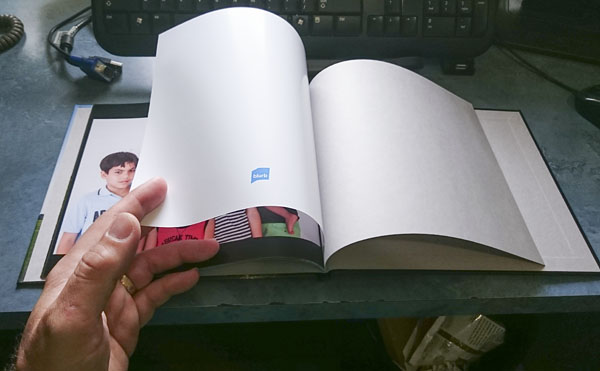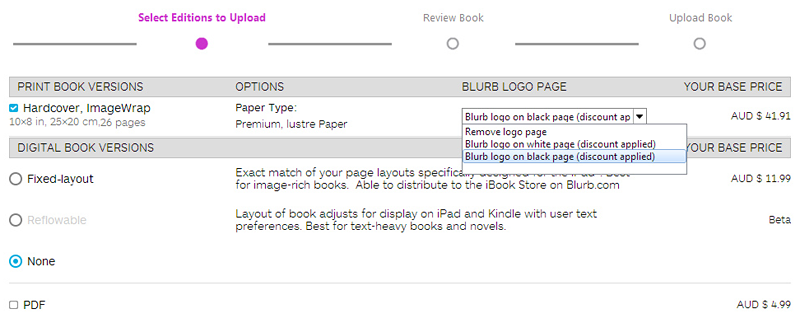
Blurb's BookSmart software for creating photobooks was first released in 2007, while BookWright was released in 2014 as a beta, and publicly released in February 2015. BookWright can import photobooks in several other formats, including Blurb's BookSmart format and Blurb's Bookify format.
According to Blurb, "Because BookWright is brand new, we have new technology available to us to make the app run smoother and faster, refresh the overall look and feel, and to incorporate new features."
It sounds like a no-brainer - BookWright should be the default choice when deciding which software to use to create a photobook for printing by Blurb. After using BookWright to create a photobook, I believe it's not a simple choice. Read on for details.
I have previously used BookSmart to create several photobooks - you can read about my experiences here.
I used BookWright to create a photobook with photos from a mission-related trip to West Timor in September last year, as an opportunity to try out BookWright, and compare it to BookSmart.
While using BookWright, I encountered a number of limitations and issues:
- Can't update saved custom page layouts
After you have saved custom page layout in BookWright, you cannot update it. You can only save custom page layouts as a new layout. BookSmart allows you to over-write previously created page layouts. - Can't delete saved custom page layouts
After a custom page layout has been saved in BookWright, you cannot delete it.
BookSmart allows you to delete previously created page layouts. - Can't view a single page
BookWright only allows you to view a two-page spread, and doesn't allow you to zoom in on a single page. If you have a large, high-resolution screen, this may not be an issue, but if you're using BookWright on a computer or laptop with a smaller screen, this is a limitation.
BookSmart allows you to switch between a single-page view and a two-page spread. - Can't view or edit the last page (logo page)
BookWright doesn't allow you to view the very last page of a book when editing or previewing it. Because this page isn't visible when previewing a book, you may not realise the colour is inconsistent with the rest of your book.
BookSmart allows you to see the last page, add content to both sides of it, and displays the last page when previewing your book. Any page background colour also applies to this last page.I recently created a book in BookWright, and set the page background to black. However, my book was printed and delivered with a last page (logo page) that was white, which completely spoiled the book for me.When uploading a book for printing from BookWright, you need to ensure you specify the appropriate colour for the logo page, as shown in the screenshot below:
After contacting Blurb support, they indicated there's an option that needs to be specified when uploading the book for printing (called "Blurb Logo Page"), to determine the colour of the final page. This is non-intuitive, and not obvious.
However, despite Blurb indicating the issue was my fault, they were good enough to provide a new discount coupon so I could get the book re-printed with the correct colour logo page (the coupon covered the printing costs, but not the shipping costs).
 white logo page in a book with all black pages (the end pages are grey)
white logo page in a book with all black pages (the end pages are grey) specifying the colour of the logo page when uploading a book
specifying the colour of the logo page when uploading a book
- Can't add content to the last page (logo page)
BookWright doesn't allow you to add any content (photos and/or text) to the very last page. The last page is referred to as the "logo page" by Blurb, and you can optionally pay extra to remove the logo from this page.
BookSmart allows you to add photos and/or text to both sides of the logo page.
 BookSmart allows you to add content to both sides of the logo page
BookSmart allows you to add content to both sides of the logo page
(page 93 is the front of the logo page, and page 94 is the back of the logo page) - Auto-Updater isn't user-friendly
When you launch BookWright on your computer, it will automatically check if a new version is available, and will immediately start downloading the new version. It doesn't prompt you that there's a new version available, and ask you if you want to download it.
This is annoying, because it means you need to wait for the download to complete, and the installation of the update to complete before you can use BookWright. Not everyone has a fast internet connection, and not everyone has an unmetered internet connection.
I have also observed that BookWright would sometimes report that a new version was available, download it, claim to have installed it, but the version number didn't change.
Note that you can disable the auto-updates on the Help->About screen.
Blurb's support website identifies several features that are available in BookSmart but not in BookWright, and recommends that "you should use BookSmart if you want:
- Planner or notebook formats
- To import blog content or a Word document
- To import from online sources like Flickr or Smugmug
- Page ornaments
- Decorative/patterned backgrounds
- Borders around images"
There are various discussion threads on Blurb's forums that echo this sentiment (for example, this thread).
I hope Blurb didn't decide to create BookWright as a complete re-write of BookSmart, because the software industry typically sees that as bad idea!
I will continue to use BookSmart while I can, as I prefer the functionality and the user experience that it provides.
Are you going to be creating your own photo books through Blurb?
Check my Blurb discount coupons for a discount code to save some money when ordering a book through Blurb.
Most of these observations were based on my experiences creating a photo book using BookWright version 1.0.67. At the time of writing, the latest version is now 1.1.104. All issues mentioned above still exist in BookWright version 1.1.104.
The version of BookSmart I am currently using is version 3.4.7.34818.



Thanks for this. I have created several books in BookSmart and just tried to start abook in BookWright. I got so frustrated that I went online to look to see if anyone else thought BookSmart was better, too... and I wasn't just a luddite!